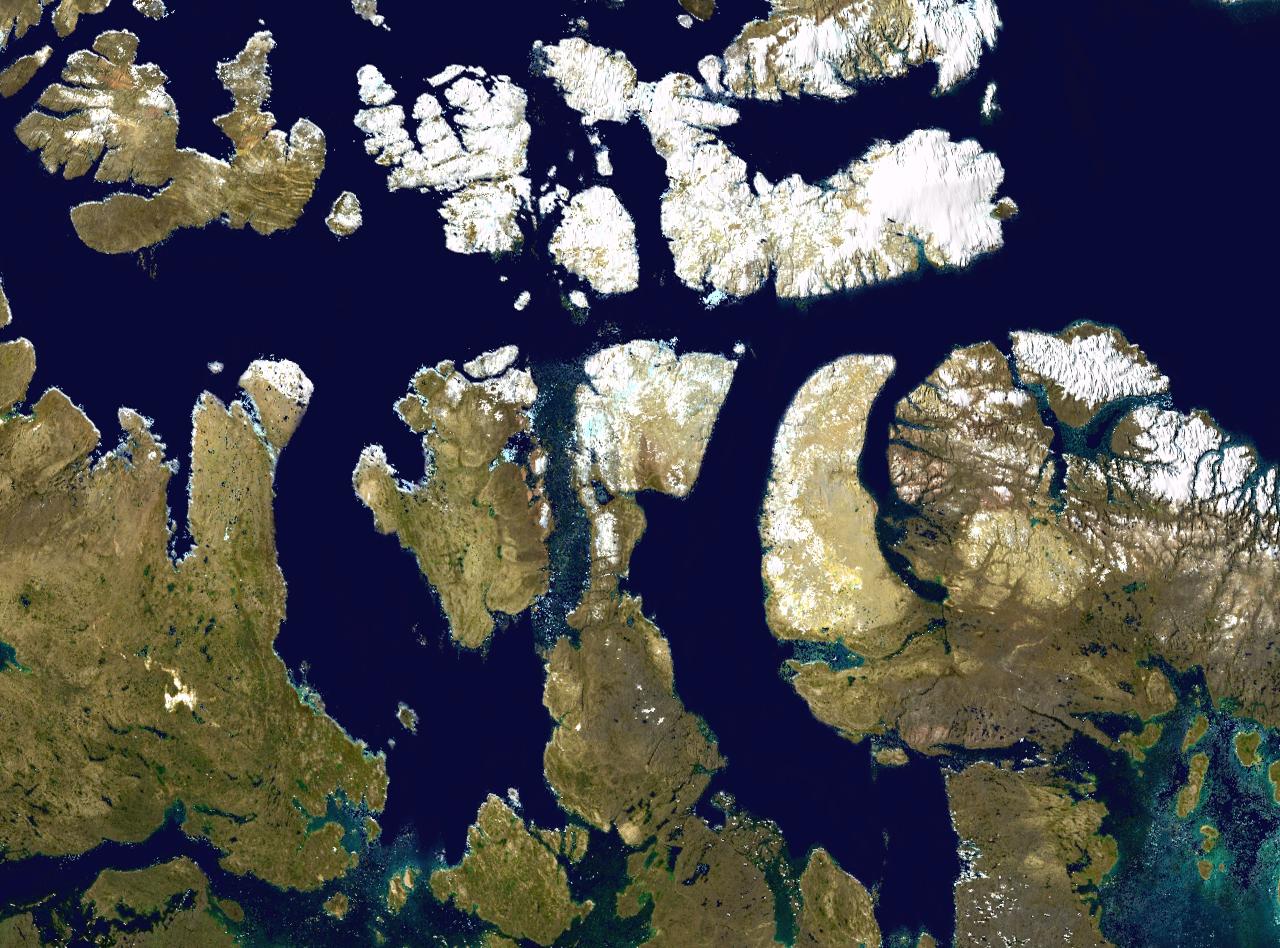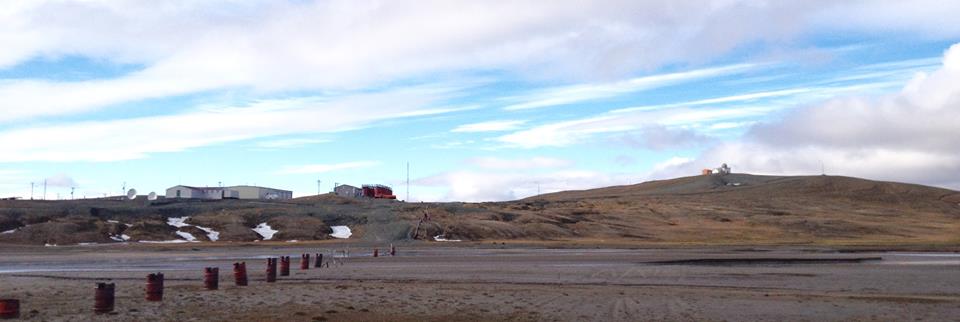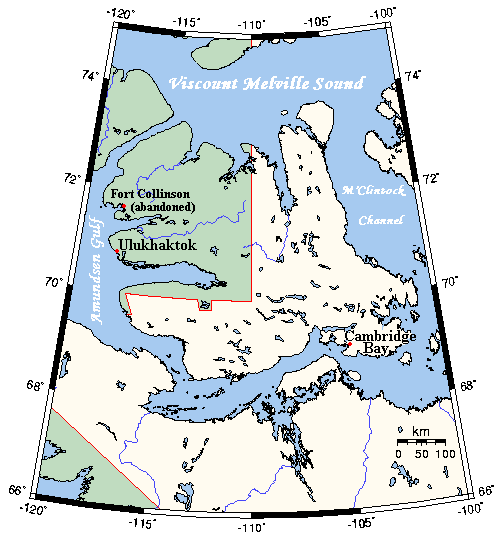|
Parry Channel
The Parry Channel (, ) is a natural waterway through the central Canadian Arctic Archipelago. Its eastern two-thirds lie in the territory of Nunavut, while its western third (west of 110° West) lies in the Northwest Territories. It runs east to west, connecting Baffin Bay in the east with the Beaufort Sea in the west. Its eastern end is the only practical entrance to the Northwest Passage. Its western end would be a natural exit from the archipelago were it not filled with ice. The channel separates the Queen Elizabeth Islands to the north from the rest of Nunavut. Named parts of the Channel are, from east to west, Lancaster Sound, Barrow Strait, Viscount Melville Sound and the McClure Strait. On the south are Baffin Island, Admiralty Inlet and the Brodeur Peninsula of Baffin Island, Prince Regent Inlet which leads to the large Gulf of Boothia, Somerset Island, Peel Sound which is the main route south, Prince of Wales Island, the ice-choked M'Clintock Channel, Victoria ... [...More Info...] [...Related Items...] OR: [Wikipedia] [Google] [Baidu] |
McClure Strait
The M'Clure Strait (sometimes rendered McClure Strait) is a strait on the edge of the Canadian Northwest Territories. It forms the northwestern end of the Parry Channel which extends east all the way to Baffin Bay and is thus a possible route for the Northwest Passage. The strait was named for Robert McClure, an Irish Arctic explorer serving in the Royal Navy. He was the first man to traverse the North-West Passage (by boat and sledge). The strait connects the Beaufort Sea in the west with Viscount Melville Sound in the east. It is bounded by Prince Patrick Island, Eglinton Island and Melville Island on the north and Banks Island on the south. As the strait is chronically blocked with thick ice, it is usually impassable to ships; in 1969, the United States-registered tanker SS ''Manhattan'' was freed from the ice by a Canadian icebreaker, and forced to travel through Canadian territorial waters to complete its westward passage. Ice prevented ''Manhattan'' from going throug ... [...More Info...] [...Related Items...] OR: [Wikipedia] [Google] [Baidu] |
Somerset Island (Nunavut)
Somerset Island (Inuktitut ''Kuuganajuk'') is a large, uninhabited island of the Arctic Archipelago, that is part of the Canadian territory of Nunavut. The island is separated from Cornwallis Island and Devon Island to the north by the Parry Channel, from Baffin Island to the east by Prince Regent Inlet, from the Boothia Peninsula to the south by Bellot Strait, and from Prince of Wales Island to the west by Peel Sound. It has an area of , making it the 46th largest island in the world and Canada's twelfth largest island. The majority of the island lies in the Qikiqtaaluk Region and is home to the summer Arctic Watch Lodge. A small southern portion lies in the Kitikmeot Region and is the site of the former Fort Ross trading post. History Around 1000 AD, the north coast of Somerset Island was inhabited by the Thule people, as evidenced by whale bones, tunnels and stone ruins. William Edward Parry was the first documented European to sight the island in 1819. HMS ''F ... [...More Info...] [...Related Items...] OR: [Wikipedia] [Google] [Baidu] |
Prince Patrick Island
A member of the Arctic Archipelago, Prince Patrick Island is the westernmost of the Queen Elizabeth Islands in the Northwest Territories of Canada, lying northwest of Melville Island (Northwest Territories and Nunavut), Melville Island. The area of Prince Patrick Island is , making it the List of islands by area, 55th largest island in the world and List of Canadian islands by area, Canada's 14th largest island. It has historically been fast ice, icebound all year, making it one of the least accessible parts of Canada. Located at the entrance of the M'Clure Strait, Prince Patrick Island is uninhabited. The first known sighting of the island was in 1853 by the Irish naval officer George Mecham, when it was explored by him and his fellow Irish explorer Francis Leopold McClintock in the spring of that year during the Edward Belcher expedition. Much later, it was named for Prince Arthur, Duke of Connaught and Strathearn, Prince Arthur William Patrick, Duke of Connaught and Strathearn ... [...More Info...] [...Related Items...] OR: [Wikipedia] [Google] [Baidu] |
Melville Island (Northwest Territories And Nunavut)
Melville IslandCoordinates are located on the NWT side. (; , ) is an uninhabited member of the Queen Elizabeth Islands of the Arctic Archipelago. With an area of , it is the 33rd largest island in the world and Canada's eighth largest island. Mountains on Melville Island, some of the largest in the western Canadian Arctic, reach heights of . Melville Island is shared by the Northwest Territories, which is responsible for the western half of the island, and Nunavut, which is responsible for most of the eastern half. The border runs along the 110th meridian west. The eastern half of the island contains two subnational pene-exclaves that lie west of the 110th meridian and form part of the Northwest Territories. These can be reached by land only from Nunavut. Geography The island is located between Prince Patrick Island in the northwest, Eglinton Island in the west, and Byam Martin Island in the east. Across Viscount Melville Sound in the south lies Victoria Islan ... [...More Info...] [...Related Items...] OR: [Wikipedia] [Google] [Baidu] |
Bathurst Island (Nunavut)
Bathurst Island is one of the Queen Elizabeth Islands in Nunavut, Canada. It is a member of the Arctic Archipelago. An uninhabited island, the area is estimated at , long and from to to wide, making it Canada's 13th largest island. It is located between Devon Island and Cornwallis Island in the east, and Melville Island in the west. Four small islands of Cameron, Vanier, Massey and Alexander lie in its northwest. The island is low-lying with few parts higher than in elevation. The highest point is at Stokes Mountain in the Stokes Range. This in turn forms part of the Arctic Cordillera mountain system. Good soil conditions produce abundant vegetation and support a more prolific wildlife population than other Arctic islands. The island contains both the International Biological Program site Polar Bear Pass and Qausuittuq National Park. History The island was first inhabited by Independence I culture peoples around 2000 BC. They were followed by Independence ... [...More Info...] [...Related Items...] OR: [Wikipedia] [Google] [Baidu] |
McDougall Sound
McDougall Sound is an Arctic waterway in Qikiqtaaluk, Nunavut, Canada. It is located between southeastern Bathurst Island and western Cornwallis island. The sound's southern mouth opens to the Parry Channel, and beyond that, to the Barrow Strait. The sound's northern mouth opens to Crozier Strait. The sound is populated by several smaller islands, the named ones including Milne Island, Little Cornwallis Island, Wood Island, Neal Islands, Truro Island, and Baker Island. McDougall Sound is the namesake of George F. McDougall who explored the sound in 1851 while wintering with Capt. Horatio Austin's search team seeking the lost Franklin Expedition. Fauna The sound is home to bearded seal. Atlantic walrus (''O. rosmarus rosmarus'') have also been charted as far west as McDougall Sound. Ethnography In his 1990 study of Paleo-Eskimo people (who preceded the Inuit), Helmer describes three occupation periods in the McDougall Sound region: Transitional Period Dorset (ca. 3000 ... [...More Info...] [...Related Items...] OR: [Wikipedia] [Google] [Baidu] |
Cornwallis Island (Nunavut)
Cornwallis Island is one of the Queen Elizabeth Islands, part of the Arctic Archipelago, in the Qikiqtaaluk Region of Nunavut in the Northern Canada, Canadian Arctic. It lies to the west of Devon Island, the largest uninhabited island in the world, and at its greatest length is about . At in size, it is the List of islands by area, 96th largest island in the world, and List of Canadian islands by area, Canada's 21st largest island. Cornwallis Island is separated by the Wellington Channel from Devon Island, and by the Parry Channel from Somerset Island (Nunavut), Somerset Island to the south. Northwest of Cornwallis Island lies Little Cornwallis Island, the biggest of a group of small islands at the north end of McDougall Sound, which separates Cornwallis Island from nearby Bathurst Island (Nunavut), Bathurst Island. Cape Airy is located at the island's southwestern extremity. Also on the southwestern coast, Griffith Island (Nunavut), Griffith Island lies directly across from t ... [...More Info...] [...Related Items...] OR: [Wikipedia] [Google] [Baidu] |
Wellington Channel
The Wellington Channel () (not to be confused with Wellington Strait) is a natural waterway through the central Canadian Arctic Archipelago in Qikiqtaaluk Region, Nunavut. It runs north–south, separating Cornwallis Island and Devon Island. Queens Channel lies to the west, separated by Baillie-Hamilton Island, Dundas Island, and Margaret Island. Explorations In 1845, Sir John Franklin wintered at Beechey Island at the channel's southeast end. In winter 1848, Franklin's ships got trapped in sea ice further south in Victoria Strait, leading to the tragic end of what became known as Franklin's lost expedition. The First Grinnell expedition, an American effort to determine the fate of Franklin's lost expedition, covered the Wellington Channel. They identified there the remains of Franklin's Beechey Island winter camp, providing the first solid clues to Franklin's activities before becoming icebound themselves. In spring 1851, the channel was explored by William Penny Cap ... [...More Info...] [...Related Items...] OR: [Wikipedia] [Google] [Baidu] |
Devon Island
Devon Island (, ) is an island in Canada and the largest desert island, uninhabited island (no permanent residents) in the world. It is located in Baffin Bay, Qikiqtaaluk Region, Nunavut, Canada. It is one of the largest members of the Arctic Archipelago, the second-largest of the Queen Elizabeth Islands, Canada's List of Canadian islands by area, sixth-largest island, and the List of islands by area, 27th-largest island in the world. It has an area of (slightly smaller than Croatia). The bedrock is Precambrian gneiss and Paleozoic siltstones and shales. The highest point is the Devon Ice Cap at which is part of the Arctic Cordillera. Devon Island contains several small mountain ranges, such as the Treuter Mountains, Haddington Range and the Cunningham Mountains. The notable similarity of its surface to that of Mars has attracted interest from scientists. History and settlement Robert Bylot and William Baffin were the first Europeans to sight Devon Island in 1616. William Parr ... [...More Info...] [...Related Items...] OR: [Wikipedia] [Google] [Baidu] |
Banks Island
Banks Island is one of the larger members of the Arctic Archipelago. Situated in the Inuvik Region, and part of the Inuvialuit Settlement Region, of the Northwest Territories, it is separated from Victoria Island to its east by the Prince of Wales Strait and from the mainland by Amundsen Gulf to its south. The Beaufort Sea lies to its west, and to its northeast M'Clure Strait separates the island from Prince Patrick Island and Melville Island. It is home to at least fourteen mammal species including the Peary caribou, barren-ground caribou, and polar bears. At one time over 68,000 muskoxen lived on the island, the majority of the world's population. However, the bacterium '' Erysipelothrix rhusiopathiae'' has led to a sharp decline in their numbers. The island is the summer home to hundreds of thousands of migratory birds who nest at Banks Island Migratory Bird Sanctuary No. 1 and Banks Island Migratory Bird Sanctuary No. 2. As of the 2016 census it had a human populati ... [...More Info...] [...Related Items...] OR: [Wikipedia] [Google] [Baidu] |
Prince Of Wales Strait
The Prince of Wales Strait is a strait in the Northwest Territories of Canada separating Banks Island to the northwest from Victoria Island to the southeast. It extends from Viscount Melville Sound in the northeast to Amundsen Gulf in the southwest. From late winter, it is filled by ice that usually does not break up until August, if at all. Its namesake, Prince of Wales Island, lies over to the east. The strait is a possible route for the Northwest Passage. The Parry Channel leads west from Baffin Bay to the strait or M'Clure Strait to the northwest. Robert McClure reached it from the west in 1850 and was frozen in. A sledge party showed that it was connected to Parry Channel;. However, he never traversed the strait; he declared confidently that the strait did connect over to the already-discovered Channel, and the coordinates he provided for the eastern exit of the strait were accurate. This is generally considered the epochal event of the discovery of the first Northwes ... [...More Info...] [...Related Items...] OR: [Wikipedia] [Google] [Baidu] |
Victoria Island (Canada)
Victoria Island () is a large island in the Arctic Archipelago that straddles the boundary between Nunavut and the Northwest Territories of Canada. It is the eighth-largest island in the world, and at in area, it is Canada's second-largest island. It is nearly double the size of Newfoundland (), and is slightly larger than the island of Great Britain () but smaller than Honshu (). The western third of the island lies in the Inuvik Region of the Northwest Territories; the remainder is part of Nunavut's Kitikmeot Region. The population of 2,168 is divided between two settlements, the larger of which is Cambridge Bay (Nunavut) and the other Ulukhaktok (Northwest Territories). The island is named after Queen Victoria, the Canadian sovereign from 1867 to 1901 (though she first became Queen in 1837). The features bearing the name "Prince Albert" are named after her consort, Albert. History Victoria Island was inhabited by the Thule culture, with five prehistoric ''qamutiik'' ... [...More Info...] [...Related Items...] OR: [Wikipedia] [Google] [Baidu] |






